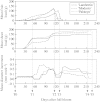Identification of biomechanical factors involved in stem shape variability between apricot tree varieties
- PMID: 14980974
- PMCID: PMC4242333
- DOI: 10.1093/aob/mch054
Identification of biomechanical factors involved in stem shape variability between apricot tree varieties
Abstract
Background and aims: Stem shape in angiosperms depends on several growth traits such as elongation direction, amount and position of axillary loads, stem dimensions, wood elasticity, radial growth dynamics and active re-orientation due to tension wood. This paper analyses the relationship between these biomechanical factors and stem shape variability.
Methods: Three apricot tree varieties with contrasting stem shape were studied. Growth and bending dynamics, mechanical properties and amount of tension wood were measured on 40 1-year-old stems of each variety during one growth season. Formulae derived from simple biomechanical models are proposed to quantify the relationship between biomechanical factors and re-orientation of the stems. The effect of biomechanical factors is quantified combining their mechanical sensitivity and their actual variability.
Results: Re-orientations happened in three main periods, involving distinct biomechanical phenomena: (a) passive bending due to the increase of shoot and fruit load at the start of the season; (b) passive uprighting at the fall of fruits; (c) active uprighting due tension wood production at the end of the season. Differences between varieties mainly happened during periods (a) and (b).
Conclusions: The main factors causing differences between varieties are the length/diameter and the load/cross-sectional area ratios during period (a). Wood elasticity does not play an important role because of its low inter-variety variability. Differences during period (b) are related to the dynamics of radial growth: varieties with early radial growth bend weakly upward because the new wood layers tend to set them in a bent position. The action of tension wood during period (c) is low when compared with passive phenomena involved in periods (a) and (b).
Figures









References
-
- AdamB, Sinoquet H, Godin C, Dones N.2000.3A version 1·0:Un logiciel pour l’Acquisition de l’Architecture des Arbres intégrant la saisie simultanée de la topologie au format AMAPmod et de la géométrie par digitalisation 3D. Guide de l’utilisateur. INRA‐PIAF: Clermont‐Ferrand, France.
-
- AlmérasT.2001.Acquisition de la forme des axes ligneux d’un an chez trois variétés d’abricotier: confrontation de données expérimentales à un modèle biomécanique Biologie, Diversité et Adaptation des Plantes Cultivées. PhD Thesis, ENSA, Montpellier.
-
- AlmérasT, Gril J, Costes E.2002. Bending of apricot‐tree branches under the weight of axillary productions: confrontation of a mechanical model to experimental data. Trees: Structure and Function 16: 5–15.
-
- ArcherR.1986.Growth stresses and strains in trees. Berlin: Springer‐Verlag.
-
- AudergonJM.1985.Contribution à l’étude de la croissance des pousses longues d’abricotier: variété Polonais. USTL‐ENSA.M.

